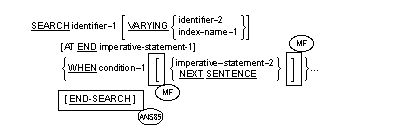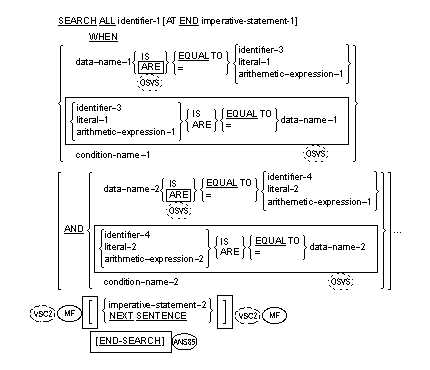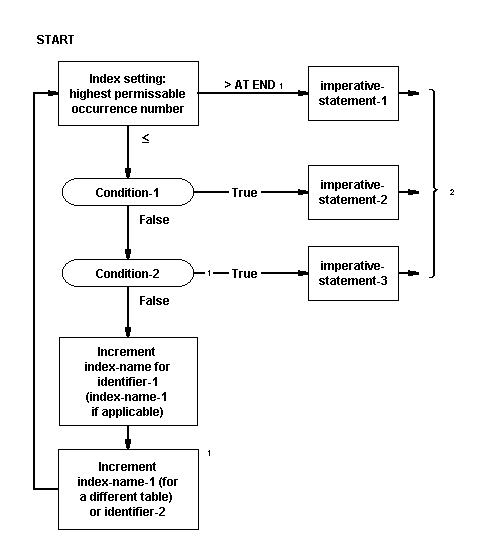The SEARCH statement is used to search a table for a table element that
satisfies the specified condition and to adjust the associated index-name to
indicate that table element.
General Format


Note that the required relational character "=" is not underlined to avoid
confusion with other symbols.
Syntax Rules
- Identifier-1 must not be subscripted or indexed, but its description
must contain an OCCURS clause and an INDEXED BY clause. The description of
identifier-1 in Format 2 must also contain the KEY IS phrase in its OCCURS
clause.
- Identifier-2, when specified, must be described as USAGE IS INDEX or as
a numeric elementary item without any positions to the right of the assumed
decimal point.
 If the END-SEARCH phrase is specified,
the NEXT SENTENCE phrase must not be specified.
If the END-SEARCH phrase is specified,
the NEXT SENTENCE phrase must not be specified.

 END-SEARCH can be specified with
NEXT SENTENCE. If the NEXT SENTENCE phrase is executed, control does not pass
to the next statement following the END-SEARCH, but instead passes to the
statement after the closest following period.
END-SEARCH can be specified with
NEXT SENTENCE. If the NEXT SENTENCE phrase is executed, control does not pass
to the next statement following the END-SEARCH, but instead passes to the
statement after the closest following period.
 Both imperative-statement-1 and
imperative-statement-2 can be replaced by a conditional statement.
Both imperative-statement-1 and
imperative-statement-2 can be replaced by a conditional statement. - Condition-1, condition-2, and so on, can be any condition as described
in the section
Conditional
Expressions in the chapter Procedure
Division.


 Identifier-1, the table
element being searched, can be an internal or external floating-point item.
Identifier-1, the table
element being searched, can be an internal or external floating-point item.
- All referenced condition-names must be defined as having only a single
value. The data-name associated with a condition-name must appear in the KEY
clause of identifier-1. Each data-name-1, data-name-2 can be qualified. Each
data-name-1, data-name-2 must be indexed by the first index-name associated
with identifier-1 along with other indices or literals as required, and must be
referenced in the KEY clause of identifier-1. Identifier-3, identifier-4, or
identifiers specified in arithmetic-expression-1, arithmetic-expression-2 must
not be referenced in the KEY clause of identifier-1 or be indexed by the first
index-name associated with identifier-1.
When a data-name in the KEY clause of identifier-1 is referenced, or
when a condition-name associated with a data-name in the KEY clause of
identifier-1 is referenced, all preceding data-names in the KEY clause of
identifier-1 or their associated condition-names must also be referenced.


 Identifier-1, the table
element being searched, cannot be a floating-point item.
Identifier-1, the table
element being searched, cannot be a floating-point item. 

 Neither data-name-1 nor
data-name-2, the key data items, can be floating-point items. However,
identifier-3, identifier-4, literal-1, or literal-2, the items against which
the key is compared, can be floating-point items.
Neither data-name-1 nor
data-name-2, the key data items, can be floating-point items. However,
identifier-3, identifier-4, literal-1, or literal-2, the items against which
the key is compared, can be floating-point items.
General Rules
- The scope of a SEARCH statement can be terminated by any of the
following:
- After execution of imperative-statement-1 or imperative-statement-2
that does not terminate with a GO TO statement, control passes to the next
executable sentence.
-
If identifier-1 is a data item subordinate to a data item that
contains an OCCURS clause (providing for a two- or three-dimensional table), an
index-name must be associated with each dimension of the table through the
INDEXED BY phrase of the OCCURS clause. Only the setting of the index-name
associated with identifier-1 (and the data item identifier-2 or index-name-1,
if present) is modified by the execution of the SEARCH statement. To search an
entire two- or three-dimensional table it is necessary to execute a SEARCH
statement several times. Prior to each execution of a SEARCH statement, SET
statements must be executed whenever index-names must be adjusted to
appropriate settings.
- If Format 1 of the SEARCH statement is used, a serial type of search
operation takes place, starting with the current index setting.
- If, at the start of execution of the SEARCH statement, the
index-name associated with identifier-1 contains a value that corresponds to an
occurrence number that is greater than the highest permissible occurrence
number for identifier-1, the SEARCH is terminated immediately. The number of
occurrences of identifier-1, the last of which is the highest permissible, is
discussed in the topic
The OCCURS
Clause in the chapter Data Division - File and
Data Description.) Then, if the AT END phrase is specified,
imperative-statement-1 is executed; if the AT END phrase is not specified,
control passes to the next executable sentence.
- If, at the start of execution of the SEARCH statement, the
index-name associated with identifier-1 contains a value that corresponds to an
occurrence number that is not greater than the highest permissible occurrence
number for identifier-1 (the number of occurrences of identifier-1, the last of
which is the highest permissible is discussed in the topic
The OCCURS
Clause), the SEARCH statement operates by evaluating
the conditions in the order that they are written, making use of the index
settings, wherever specified, to determine the occurrence of those items to be
tested. If none of the conditions is satisfied, the index name for identifier-1
is incremented to obtain reference to the next occurrence. The process is then
repeated using the new index-name settings unless the new value of the
index-name settings for identifier-1 corresponds to a table element outside the
permissible range of occurrence values, in which case the search terminates as
indicated in General Rule 4a above. If one of the conditions is satisfied upon
its evaluation, the search terminates immediately and the imperative statement
associated with that condition is executed; the index-name remains set at the
occurrence which caused the condition to be satisfied.
- If the VARYING phrase is not used, the index-name that is used for the
search operation is the first (or only) index-name that appears in the INDEXED
BY phrase of identifier-1. Any other index-names for identifier-1 remain
unchanged.
- If the VARYING index-name-1 phrase is specified, and if index-name-1
appears in the INDEXED BY phrase of identifier-1, that index-name is used for
this search. If this is not the case, or if the VARYING identifier-2 phrase is
specified, the first (or only) index-name given in the INDEXED BY phrase of
identifier-1 is used for the search. In addition, the following operations
occur:
- If the VARYING index-name-1 phrase is used, and if index-name-1
appears in the INDEXED BY phrase of another table entry, the occurrence number
represented by index-name-1 is incremented by the same amount as the index-name
associated with identifier-1, and at the same time.
- If the VARYING identifier-2 phrase is specified, and identifier-2
is an index data item, then the data item referenced by identifier-2 is
incremented by the same amount as the index-name associated with identifier-1,
and at the same time. If identifier-2 is not an index data item, the data item
referenced by identifier-2 is incremented by the value (1) at the same time as
the index referenced by the index-name associated with identifier-1 is
incremented.
- The results of the SEARCH ALL operation are predictable only when:
- The data in the table is ordered in the same manner as described in
the ASCENDING/DESCENDING KEY clause associated with the description of
identifier-1, and:
- The contents of the key(s) referenced in the WHEN clause are
sufficient to identify a unique table element.
- If Format 2 of the SEARCH statement is used, a non-serial type of
search operation can take place; the initial setting of the index-name for
identifier-1 is ignored and its setting is varied during the search operation
with the restriction that at no time is it set to a value that exceeds the
value which corresponds to the last element of the table, or that is less than
the value that corresponds to the first element of the table. The length of the
table is discussed in the topic
The OCCURS
Clause). If any of the conditions specified in the
WHEN clause cannot be satisfied for any setting of the index within the
permitted range, control is passed to imperative-statement-1 of the AT END
phrase, when specified, or to the next executable sentence when this phrase is
not specified; in either case the final setting of the index is not
predictable. If all conditions can be satisfied, the index indicates an
occurrence that allows the conditions to be satisfied, and control passes to
imperative-statement-2.
- The index-name that is used for the search operation is the first (or
only) index-name that appears in the INDEXED BY phrase of identifier-1. Any
other index-names for identifier-1 remain unchanged.


 Neither imperative-statement-2
nor NEXT SENTENCE is required. Without them, the SEARCH statement sets the
index to the value in the table that matched the condition.
Neither imperative-statement-2
nor NEXT SENTENCE is required. Without them, the SEARCH statement sets the
index to the value in the table that matched the condition.
Comments:
Figure 1 shows a
flowchart of a Format 1 SEARCH operation containing two WHEN phrases.

Figure 1: Flowchart of SEARCH Operation Showing Two WHEN Phrases
| 1 |
These operations are options included only when specified
in the SEARCH statement |
| 2 |
Each of these control transfers is to the next executable
sentence unless the imperative-statement ends with a GO TO statement. |



![]()
![]() END-SEARCH can be specified with
NEXT SENTENCE. If the NEXT SENTENCE phrase is executed, control does not pass
to the next statement following the END-SEARCH, but instead passes to the
statement after the closest following period.
END-SEARCH can be specified with
NEXT SENTENCE. If the NEXT SENTENCE phrase is executed, control does not pass
to the next statement following the END-SEARCH, but instead passes to the
statement after the closest following period. ![]() or END-IF
or END-IF
